How Are Metamorphic Rocks Formed Metamorphic Rock Mineral Makeup
4.3: Metamorphic Rocks
- Page ID
- 12683
In this lesson you lot volition larn about metamorphic rocks, how they course, and some of their common uses. Effigy 4.13 shows a big outcrop of metamorphic rocks. Notice the platy layers that run from left to right within the rock. It looks as though y'all could easily intermission off layers from the forepart surface of the outcrop. This layering is a result of the process of metamorphism. Metamorphism is the changing of rocks by heat and force per unit area. During this process, rocks change either physically and/or chemically. They change and then much that they become an entirely new rock.

Effigy 4.13: The platy layers in this large outcrop of metamorphic rock show the furnishings of pressure on rocks during metamorphism.
Lesson Objectives
- Describe how metamorphic rocks are formed.
- Draw the properties of some common metamorphic rocks.
- Relate some common uses of metamorphic rocks.
Metamorphism
Metamorphic rocks start off as igneous, sedimentary, or other metamorphic rocks. These rocks are changed when heat or force per unit area alters the existing rock's physical or chemical make up. One ways rocks may modify during metamorphism is by rearrangement of their mineral crystals. When rut and pressure level alter the surroundings of a rock, the crystals may respond by rearranging their construction. They will class new minerals that are morestable in the new environment. Extreme pressure may likewise lead to the formation offoliation, or flat layers in rocks that form every bit the rocks are squeezed past force per unit area. Foliation usually forms when pressure level was exerted on a stone from one direction. If pressure level is exerted from all directions, then the rock usually does non testify foliation.
There are 2 principal types of metamorphism:
- Contact metamorphism—occurs when magma contacts a rock, irresolute it by extreme heat (Figure 4.14).
- Regional metamorphism—occurs when great masses of rock change over a broad area due to pressure exerted on rocks at plate boundaries.

Figure 4.14: This diagram shows hot magma inside the earth contacting diverse rock layers. This is an instance of contact metamorphism.
It is important to note that metamorphism does not crusade consummate melting of the initial stone. It merely causes changes to a stone past heat or pressure level. The rearrangement of the mineral crystals is the near mutual style that nosotros notice these changes. Tabular array 4.3 shows some common metamorphic rocks and the original rocks that they come up from.
| Picture | Rock Name | Type | Comments |
|---|---|---|---|
| | Slate | Foliated | Metamorphism of shale |
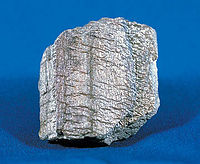 | Phyllite | Foliated | Metamorphism of slate, but under greater heat and pressure than slate |
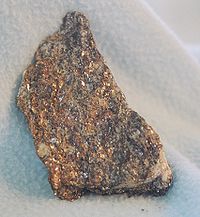 | Schist | Foliated | Ofttimes derived from metamorphism of claystone or shale; metamorphosed under more heat and pressure than phyllite |
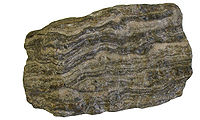 | Gneiss | Foliated | Metamorphism of diverse different rocks, under extreme conditions of heat and pressure |
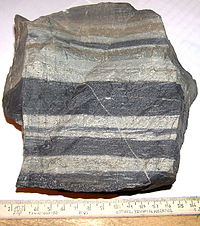 | Hornfels | Non-foliated | Contact metamorphism of diverse different rock types |
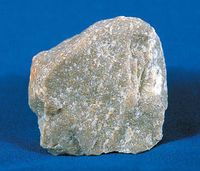 | Quartzite | Non-foliated | Metamorphism of sandstone |
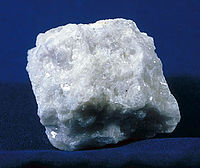 | Marble | Non-foliated | Metamorphism of limestone |

Figure four.fifteen: Marble is used for decorative items and in art.
Hornfels, with its alternating bands of nighttime and light crystals is a good example of how minerals rearrange themselves during metamorphism. In this instance, the minerals separated by density and became banded. Gneiss forms by regional metamorphism from both high temperature and pressure.
Quartzite and marble are the most unremarkably used metamorphic rocks. They are frequently chosen for building materials and artwork. Marble is used for statues and decorative items similar vases (Figure iv.15). Basis upwardly marble is also a component of toothpaste, plastics, and paper. Quartzite is very hard and is often crushed and used in edifice railroad tracks (Figure 4.16). Schist and slate are sometimes used as building and mural materials.

Figure four.16: Crushed quartzite is sometimes placed nether railroad tracks because it is very hard and durable.
Lesson Summary
- Metamorphic rocks grade when oestrus and pressure level transform an existing rock into a new rock.
- Contact metamorphism occurs when hot magma transforms stone that it contacts.
- Regional metamorphism transforms big areas of existing rocks under the tremendous heat and force per unit area created by tectonic forces.
Review Questions
- Why do the minerals in a stone sometimes rearrange themselves when exposed to heat or pressure?
- What is foliation in metamorphic rocks?
- Draw the unlike weather condition that lead to foliated versus not-foliated metamorphic rocks.
- List and depict the two main types of metamorphism.
- How can metamorphic rocks be a clue to how they were formed?
- Suppose a phyllite sample was metamorphosed once again. How might it wait dissimilar after this 2nd round of metamorphism.
Vocabulary
- contact metamorphism
- Results from temperature increases when a torso of magma contacts a cooler existing stone.
- foliation
- Property of some metamorphic rocks in which flat layers are formed; seen as evidence of squeezing by pressure.
- regional metamorphism
- Occurs when bang-up masses of rock change over a broad area due to pressure level.
- stable
- Steady and not likely to change significantly whatever more than.
Points to Consider
- What type of plate boundary would produce the most intense metamorphism of rock?
- Do yous think new minerals could form when an existing rock is metamorphosed?
Source: https://geo.libretexts.org/Courses/Lumen_Learning/Book%3A_Earth_Science_(Lumen)/04%3A_Rocks/04.3%3A_Metamorphic_Rocks
Posted by: mitchelljohicad1985.blogspot.com

0 Response to "How Are Metamorphic Rocks Formed Metamorphic Rock Mineral Makeup"
Post a Comment